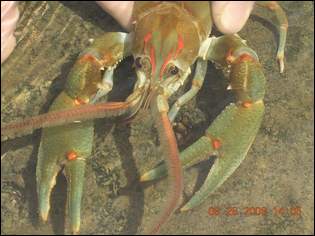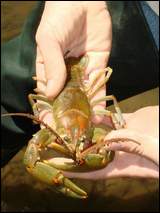![]()
Scientists fish for more data about Tennessee's huge crawfish
The Tennessean
Dec. 24, 2007


Crawfish the size of dinner plates live in a few Middle Tennessee and Kentucky streams, and nowhere else, and scientists want to know more about them.
The state needs information about the location of the species as more permits are sought for water withdrawals, gravel dredging and other activities that affect streams.
The huge crawfish have been reported only in waterways that are part of the Green and Barren river systems. The first is in Kentucky, but both states share the Barren River watershed.
To protect the species, officials won't give away exact locations found, but they include parts of the Middle and West Fork Drakes Creek in Sumner County and Line Creek in Clay County.
Tennessee has at least 78 species of crawfish, which may be more than any other state, according to the Tennessee Wildlife Resources Agency.
Nine are considered endangered by the state. One, the Nashville crayfish, is listed as federally endangered and has been central to opposition to a marina planned on Mill Creek near downtown.
Another state resident, the Cajun dwarf crawfish, is, as an adult, shorter than the diameter of a quarter.
The abundance of crawdad species is attributed to the state's varied topography (from mountains to swampy bottomlands), its many streams and its location between the more extreme northern and southern climes.
Also called 'Barbi'
At up to 9 inches from claw to tail, Barbicambarus cornutus, the crawfish state biologists have documented, is the largest of the crawfish here.
"It's not just a species restricted to a single watershed," state biologist David Withers said of the creature he refers affectionately to as "Barbi."
"It's the only one in its genus."
That means they are not even "close cousins," he said.
Aside from its size, this species is distinguished by feathery antennae that resulted in the common name of bottlebrush crawfish.
They tend to be reclusive, and Withers doesn't know how many there might be, nor how big the largest are here.
"The traditional way of looking at the world of crayfish is the bigger the rock, the bigger the crayfish underneath," he said.
"You've got rock you can't pick up, but you know they're there."
Unaware anglers are among the threats to the state's species.
Bait shops have begun selling live crawfish brought from other states, and some folks are dumping those they don't use after fishing in the waterway they're on, according to TWRA.
One, the aggressive rusty crayfish, is taking over the habitat from the locals, so far mainly in parts of East Tennessee.
Mack Prichard, the state's first naturalist, recalls his father in West Tennessee showing him how in the Great Depression he would lure burrowing crawfish.
The species lives in holes with "chimneys" of mud, and can be lured out with a bit of meat on a line.
The next step was to skewer the creature on a stick, and cook it over a flame, he said.
That's something that Withers would not try and doesn't recommend with Barbi, which is not a burrowing crawfish.
"They're too precious," he said.
Crawfish facts
- Crawfish are 10-legged aquatic relatives of crabs and lobsters.
- They are food for smallmouth bass and other fish and humans.
- There are 550 species worldwide.
- Freshwater crawfish live on all continents except Africa and Antarctica.
- The world's largest species (native to the Australian island of Tasmania) can weigh 12 pounds and be more than two feet long.
SOURCE: TENNESSEE WILDLIFE RESOURCES AGENCY